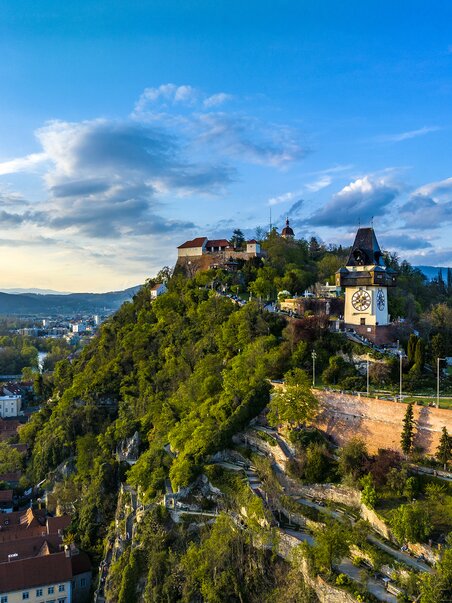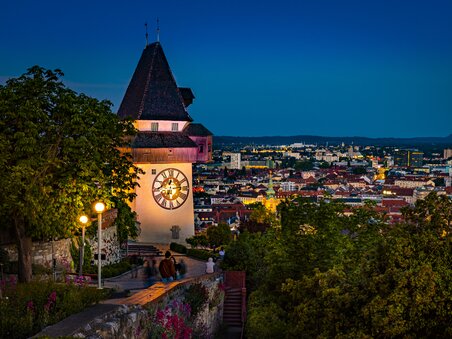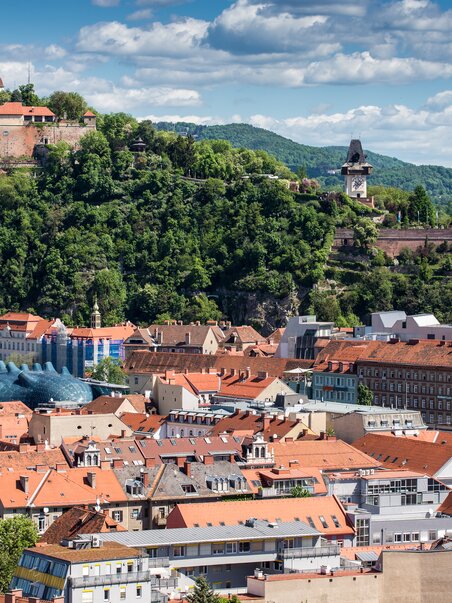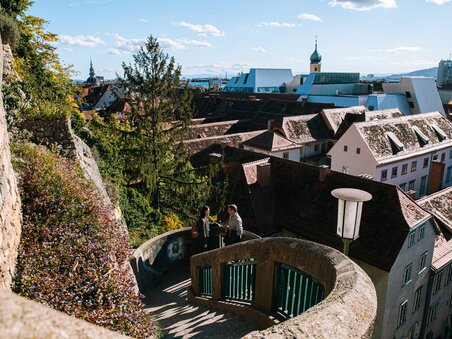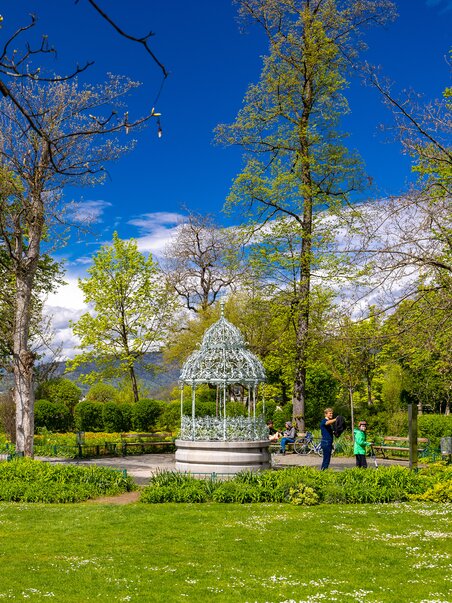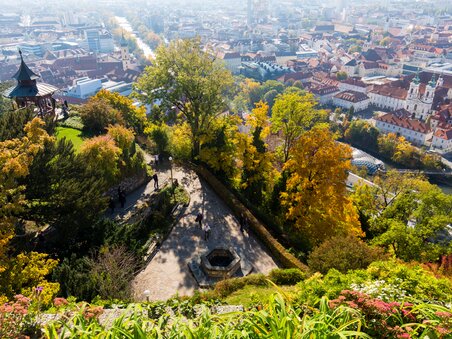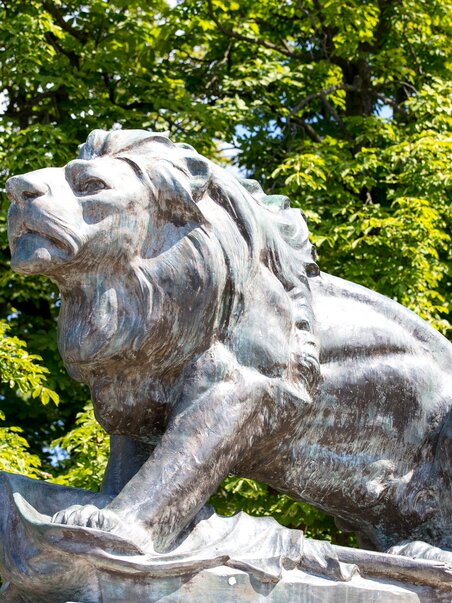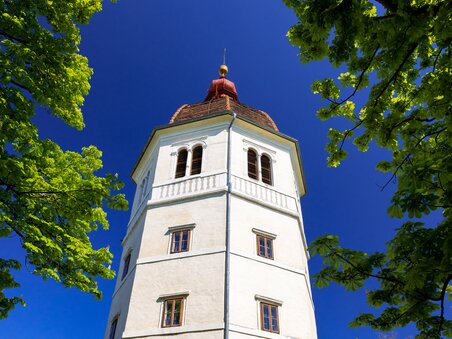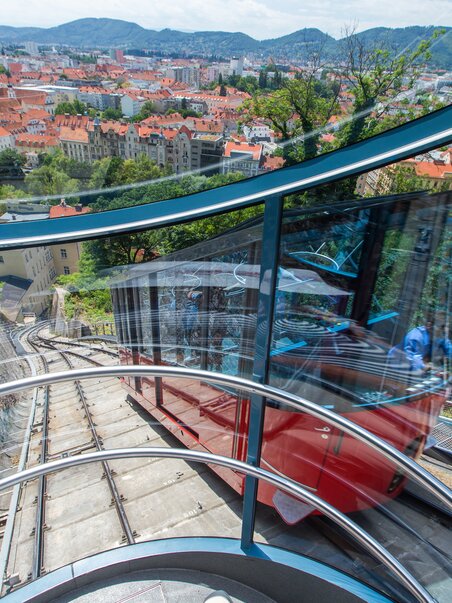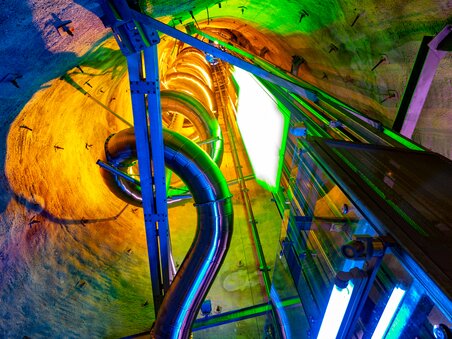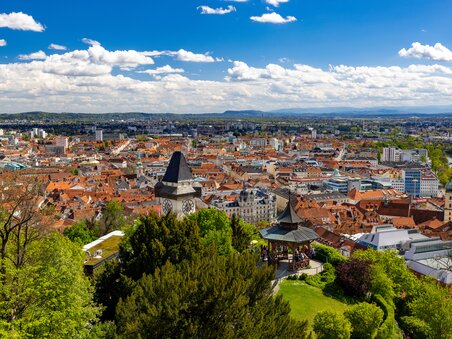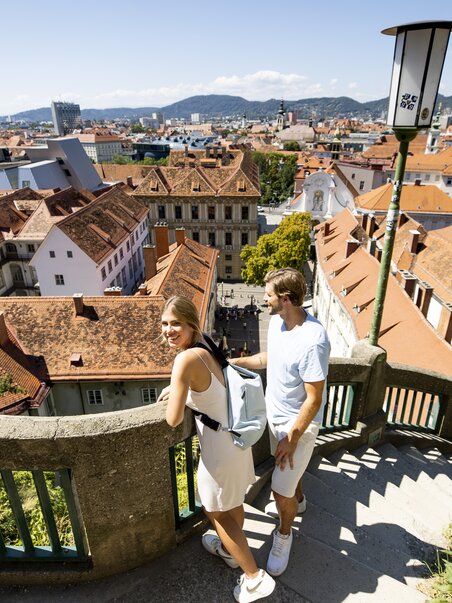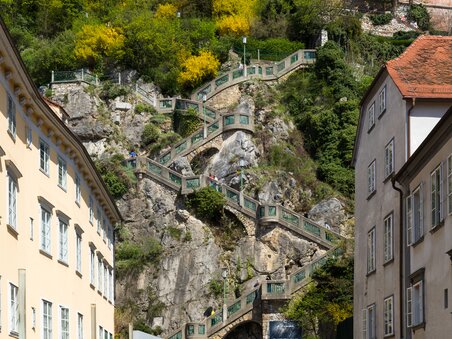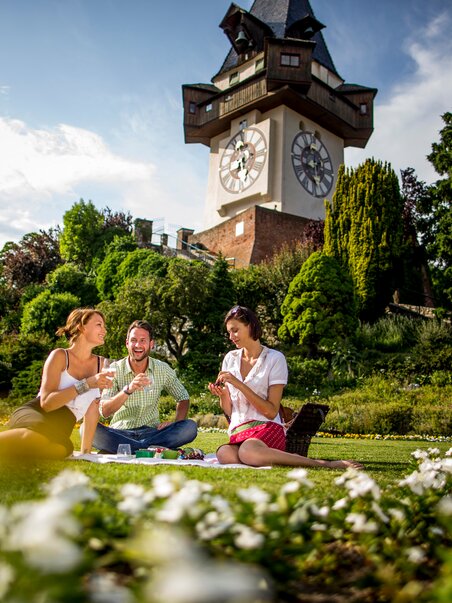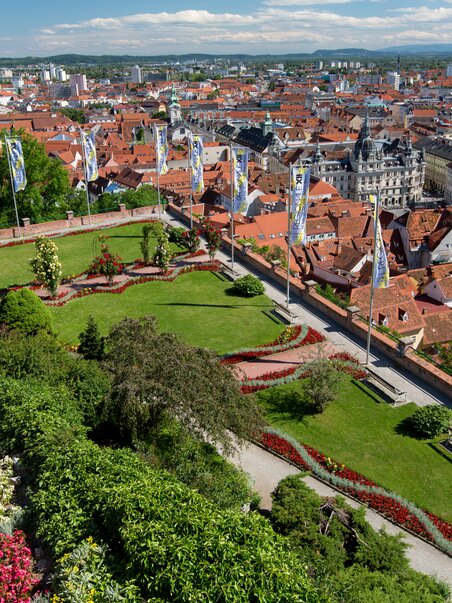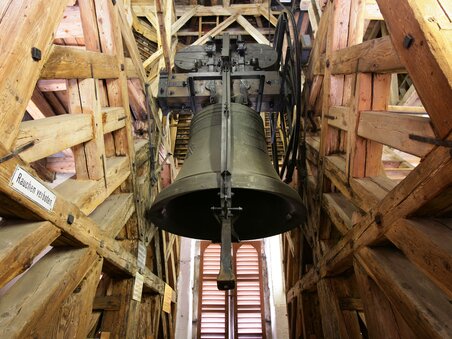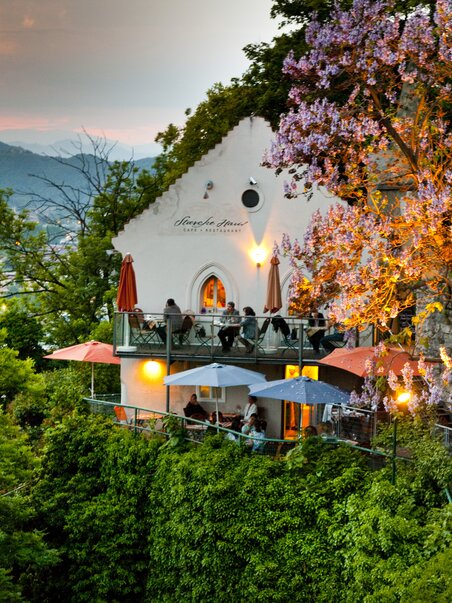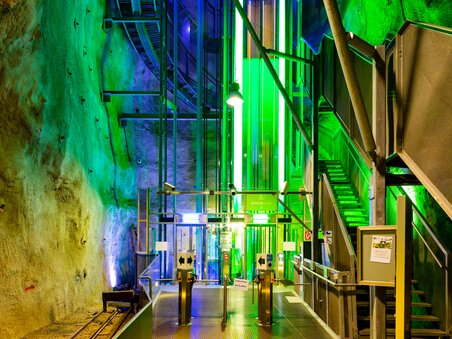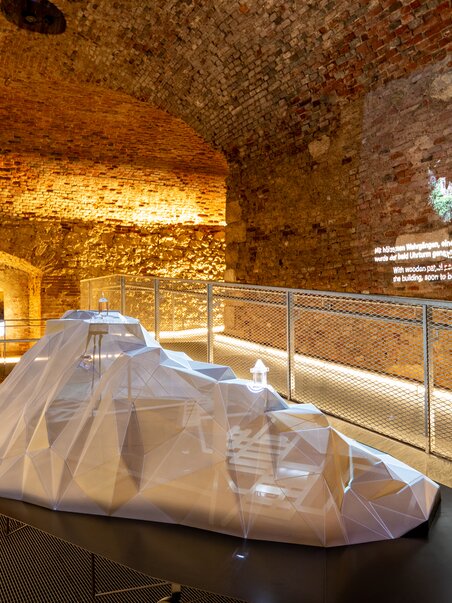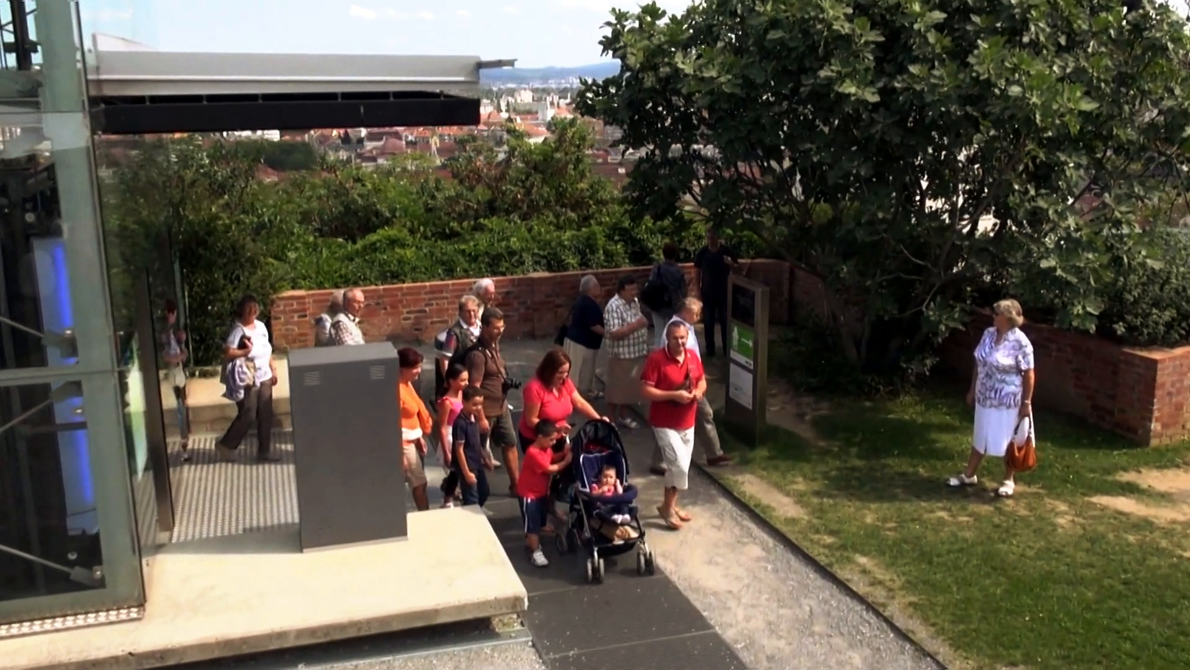- family
- Sights around the Schlossberg
Schlossberg
Enjoy the view from the Schlossberg in Graz in the middle of the old town.
There are four ways to get to the top of the 473-metre high Schlossberg: on the Schlossberg Funicular railway, in the glass lift that ascends inside the mountain or on foot up the Schlossbergstiege stairs and via Karmeliterplatz.
Over 1,000 years ago the small fort that stood on a rock ledge here gave the city its name. Derived from the Slavic word ‘Gradec’, Graz means “little castle”. After 1544, according to plans drawn up by Domenico dell’Allio, it was extended into a huge Renaissance fortress, now listed in the Guinness Book of Records as the strongest ortification of all time. Even Napoleon found it impossible to capture at the beginning of the 19 th century; it was only in 1809, when he had occupied Vienna and was threatening to destroy the Austrian capital, that Graz surrendered. Almost all of the fortifications were razed to the ground – only the bell tower and clock tower were allowed to remain, ransomed by the citizens of Graz and so spared.
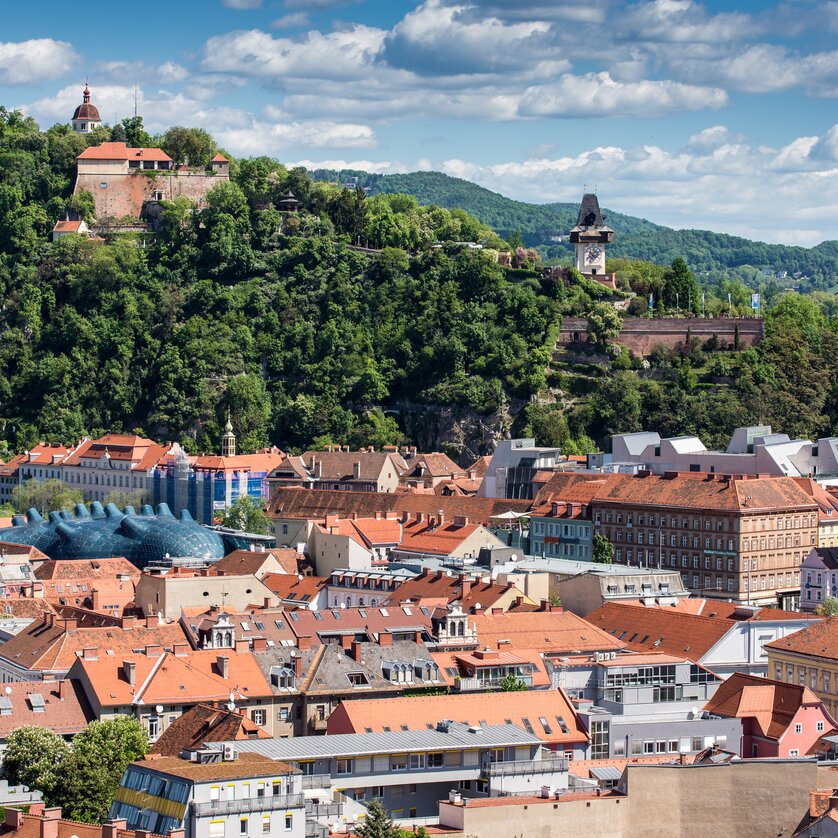
Good to know
There are four ways to get to the top of the 473-metre high Schlossberg:
- By foot via the 260 steps of the Felsensteig from Schlossbergplatz. The steps were carved into the cliff by prisoners of war during the First World War.
- Alternatively, you can find paths leading to the Schlossberg from Karmeliterplatz or Wickenburggasse.
- By taking the Schlossberg Funicular: The Schlossbergbahn (funicular railway) can be reached from the Hauptplatz by following Sackstraße past Schlossbergplatz as far as Kaiser-Franz-Josef-Kai. It ascends from the lower station at an incline of 61 % – as it has done for the last 100 years. (Graz Linien public transport
tickets are valid.). The ride takes less than 2 minutes. - By using the Schlossberg Lift, you can reach the Schlossberg in about 1 minute - the entrance of the lift is located directly at Schlossbergplatz. It is an unusual, fast and yet comfortable way to achieve the ascent of Schlossberg hill. The altogether aesthetically appealing design of this lift, set in the very core of the hill, is also particularly practical if you’re in a hurry or not inclined or able to walk. During the ride, the lift’s glass cabins offer a clear view of the illuminated rocklined elevator shaft – a mountain view from within.
The Schlossberg, with a height of 473 meters, is the highest natural point of the city and offers a breathtaking 360° panoramic view.
Once you’re on top of the Schlossberg there’s a lot to discover and a fabulous view to enjoy: from here you can see the red-tile roofscape, the hills and the mountains in the distance.
- BELL TOWER: Our first stop on the Schlossberg is the bell tower, built in 1588, which houses Graz’s most famous bell, the “Liesl”. It is unclear whether the name originates from an earlier chapel dedicated to St. Elisabeth or from the word “Verlies”, meaning dungeon (the fortress’s cruellest prison was in the cellar vault). The bell weighs nearly 5 tonnes: it took two blacksmiths working full tilt to construct the special ringing mechanism that allowed it to sound.
- KASEMATTEN STAGE: Do you have any idea what a ‘casemate’ was? Casemates were stores that were also used as sleeping quarters for prisoners. Today the Kasematten stage is the atmospheric backdrop for dazzling operas and concerts. From here it is not far to the plateau at the top and the Gothic fortress gate.
- THE GOTHIC GATE: Rediscovered in 1982, the fortress gate led from the “outer ward” to the interior of the Medieval castle and was known as the “back gate”. In the Middle Ages there was a crenellated gate tower with two archways, the outer of which is still well preserved today. In 1894 the plateau was made into a panoramic terrace. The Gothic gate was excavated between 1998 and 2001 and made accessible to the public.
- HACKHER LION: The Hackher Lion is a monument to the last military defender of the Graz fortress, Major Franz Xaver Freiherr von Hackher, who in 1809 together “with a handful of soldiers” withstood months of siege laid by the superior forces of the French. Since there was no portrait of Major Hackher a statue of a lion was erected in his honour instead. In the middle of the plateau area is the cistern. This huge cistern was built in the 16th century and has a capacity of 900,000 litres.
- GRAZ MUSEUM SCHLOSSBERG: The new Graz Museum Schlossberg opens the door on the history of the city hill in Graz. Open all year round and partly an open-air museum, it is the first point of contact for all visitors to the Schlossberg. Graz Museum Schlossberg provides visitors with information and orientation with regard to history and topography. This new, family-friendly museum presents the history of the Schlossberg and its significance for Graz in a contemporary way.
- CANNON HALL: The cannon hall in Graz Museum Schlossberg houses four cannons, which remind us of the old cannon bastion’s function as the main Graz fire station.
- CHINESE PAVILION: The Chinese Pavilion was built in 1890 and replaced an older Romanesque vine-covered terrace. The stone bench with weathered inscriptions and Gothic tracery on the rear side is known as the “Bishop’s seat” since, according to legend, it was here in 1796 that, released after enduring 40 years’ prisonment in the dungeons of the Schlossberg, the Bishop Count Nádasdy died.
- THE TURKISH WELL: From 1554 to 1558 this “deep well” was dug 94 metres down to the groundwater of the Mur in order to be able to provide the fortress with enough water during prolonged sieges. It acquired its current name only in the 19th century, because there were supposedly Turkish prisoners involved in digging it.
- STARCKE-HAUS: In 1575 a powder tower was built at the foot of the stable bastion which was then destroyed by the French in 1809. A winegrower’s house was built on its ruins and grapes planted on the terraces below. It was named after court actor Gustav Starcke, who lived in the house. Today it houses a restaurant with terraces providing a wonderful view over Graz.
- CLOCK TOWER: And finally you come to the clock tower, the traditional landmark of the city. And, although the clockwork in the 28-metre high tower has struck the hour precisely since 1712, it is still possible to lose track of time beneath this romantic symbol of Graz with its wonderful view over the city. The originally Medieval defence tower acquired its current structure in around 1560, as did the distinctive wooden walkway for the fire brigade. Three bells strike in the clock tower and three crests adorn its walls.
- HERBERSTEINGARTEN: In 1930 access was opened up to the Herbersteingarten from the “Kriegssteig”, so that the “hanging gardens of Graz” could be visited by the public. Mediterranean plants (such as fig trees, lemon trees, ginko trees and wisteria) make the terrace one of the finest examples of garden architecture from the interwar years.
- THE SYSTEM OF TUNNELS IN THE MOUNTAIN: During the Second World War, an extensive system of tunnels was built inside the mountain, which served as air raid shelters for up to 40,000 people. Some of these tunnels are still in use today; for example as a footpath through the mountain from Schlossbergplatz to Karmeliterplatz, or as access to the glass lift in the mountain and to Dom im Berg, an underground event hall. The Graz Fairytale Express in the Schlossberg also uses part of the old system of tunnels..
- SLIDE GRAZ & THE FLIGHT GRAZ 4D MOTION RIDE: Slide Graz in the Schlossberg is the tallest underground slide in the world at 64 metres. Whizzing down spiralling bends on 175 metres’ of track in about 40 seconds, this is a very special experience for all ages. The Flight Graz 4D Motion Ride takes visitors to more than 25 attractions in the city on an exciting drone flight from the perspective of a fly. You can experience Graz like never before thanks to full motion chairs and effects such as wind, fog, soap bubbles and water.
Details
The Schlossberg. It attracts people. In springtime by fresh green, the first warm rays of sunshine, in summer by shady trees and open-air performances, in autumn by the blaze of colours, and in winter you can escape to it from dull routine in the city. And all that within a few minutes. Since 1894 the Schlossbergbahn funicular has mastered the gradient of about 60% perfectly - lately with new observation cars. On top of the hill there is much to discover.
The Bell Tower dating from the 16th century. Inside it - the "Liesl", the heaviest bell of Graz. There is the casemate open-air stage in the former cellars of the destroyed main building of the fortress. A cistern, the Türkenbrunnen (Turkish well), 94m deep, and the mighty Stallbastei bastion were all built by Domenico dell'Aglio. He was leading among the architects from Northern Italy who in the mid-16th century erected new city walls in Graz and a 400m-long fortress on Schlossberg. No one could take this fortress. Not even Napoleon. However, after a victory over the Habsburgs in 1809, Napoleon demanded the demolition of the fortress. A huge amount of money paid to the French by the burghers of Graz could prevent the Clock Tower and the Bell Tower from being destroyed. Thirty years later, Baron of Welden transformed the former fortress hill into the romantic park with its southern plants, which it is still today. The c. 260 steps of Schlossbergtreppe lead you downwards. As does the glass lift which terminates in the Schlossberg tunnel system. The latter was built in World War I as an air-raid shelter for the people of Graz.
Today it houses not only a grotto railway for the little ones but also the "Dom im Berg", an event and exhibition hall equipped with state-of-the-art technical infrastructure - and all that in the centre of a rock.
By the way: According to legend, it was the devil himself who created Schlossberg. He had promised the people of Graz to make their local mountain, the Schöckl, higher. Of course, in exchange for the first soul climbing up heightened Schöckl. When flying over Graz with a huge rock from Africa in his hands, he caught sight of a procession. It was on Easter Sunday. On which he had no power over humans. And therefore he could not win any soul. In (un-)righteous anger Satan threw the rock onto the town. The rock broke in two parts. Today the smaller one is Austein with its Calvary. The bigger one is Schlossberg.
